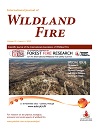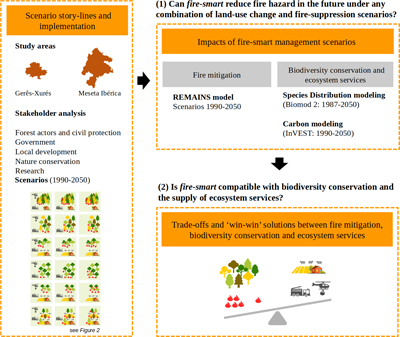International Journal of Wildland Fire
Volume 32
Number 6 2023
Special Issue
IX International Conference on Forest Fire Research and 17th International Wildland Fire Safety Summit (Part 3)
Guest Editors:
Miguel Almeida (Conference Scientific Committee, Coimbra, Portugal)
Michael Flannigan (Conference Scientific Committee Chair, Edmonton, Canada)
Luís Mário Ribeiro (Conference Co-chair, Coimbra, Portugal)
Domingos Viegas (Conference Chair, Coimbra, Portugal)
Part 3 of the special issue that resulted from the 9th International Conference on Forest Fire Research includes 15 papers on various aspects of wildland fire research. Part 1 and 2 were published in January and March 2023 respectively. All papers in the special issue are published Open Access.
This paper presents a cellular automata model to simulate flaming and smouldering wildfires in peatlands over long duration, which, for the first time, considers daily variations in peat moisture. The model reveals that smouldering burned area varies widely depending on the daily variations in moisture.
Drought in fire danger rating is often estimated using weather-based models. The following study explores the potential to supplement drought estimates with soil moisture content measurements from electronic soil moisture probes, and estimates from land surface models that include remotely sensed soil moisture within the boreal forests of Canada.
This work describes the development and validation of a burned area product at a spatial resolution of 0.05° (~5 km) for the boreal region between 60°N and 72.5°N from 1982 to 2020. This satellite-based dataset constitutes unique long-term burned area information of interest for fire and carbon dynamics studies.
Vector wind change was explored with station and gridded data over New Zealand and compared with the Fire Weather Index. Vector wind change was used to create a modified Fire Weather Index that incorporates sudden wind changes into fire danger prediction.
This study tests three different erosion prediction tools to identify areas with erosion rates above the 95th percentile, in the first year after a fire, and which required recalibration based on fire characteristics.
Forest fuel moisture content is an important parameter that determines fire risk; therefore, its accurate prediction has great importance. Sorption processes of 10-h Pinus pinaster branches were studied based on field and laboratory work, resulting in a model that showed high moisture content prediction ability.
Effects of fuel structure on physical phenomena controlling flame spread is complicated by the porous nature of wildland fuels. This study experimentally investigates heat transfer in pine needle fuel beds (across a range of fuel structural conditions) in order to characterise these effects and the resulting variations in fire behaviour.
We carried out controlled gorse burning experimentsusing specialised drone-mounted instrumentation to measure fire movement and duration. We then compared the results with detailed maps of vegetation height measured before the experiment. The results provide new insight on the role of the arrangement of vegetation in the development of wildfires.
The FirESmart project sheds light on how renewed EU agroforestry policies could benefit open habitat dwelling species while providing further fire suppression opportunities. If these policies continue to fail, the use of fire can enhance ‘climate-smart’ strategies such as ‘rewilding’ or ‘tree-planting’ in mountain areas across Southern Europe (https://youtu.be/x7ouTIBp__E).
Two fires that started near Pedrógão Grande in June 2017 were affected by the presence of a thunderstorm in the region, spread out of control and merged, producing a very fast spreading fire. A laboratory scale study of this fire showed good qualitative and quantitative agreement with the full-scale observations.
Wildfires are a growing threat, especially in Mediterranean climate areas during periods of drought. However, knowledge about the effect of wildfire stresses on plants remains lacking. This work addresses the effect of combined hydric and thermal stresses on Rosmarinus officinalis and Cistus albidus, which are widely consumed in Mediterranean wildfires.
Combustion characteristics of dead Mediterranean vegetation were studied in the absence of wind. Anomalous relaxation of the fuel’s mass accompanied by anomalous diffusion of gas particles was observed during flaming combustion. The fuels’ combustion characteristics (burning rate, flame height and temperature, gas velocity) and relaxation properties were analysed and compared.
A post-fire case study of the 2018 Camp Fire identified 23 entrapment and burnover events that threatened the life safety of evacuating civilians and responding emergency personnel. The high number of events within one fire incident suggests this may be a more frequent issue specifically in the context of WUI fires.
Fundamental fire behaviour during flame spread across a pine needle bed was investigated, focusing on the dynamic nature of fire and how this impacts fire spread using cameras, temperature, and velocity. Intermittent flame spread is observed in the form of leaps caused by point ignitions due to flame contact.
A tool for quantitative assessment of dwelling vulnerability to wildfire at the wildland–urban interface is presented. Structural vulnerabilities and fire spread on properties are tackled through a fuzzy logic approach informed by expert opinion. The tool was tested with real-world data from two case studies of WUI fires in Spain.







